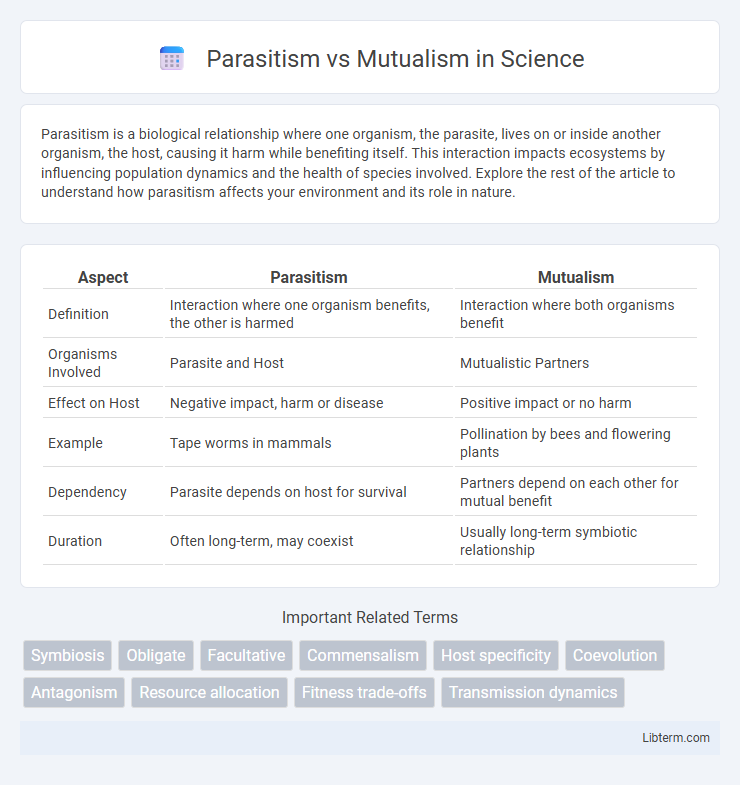Parasitism is a biological relationship where one organism, the parasite, lives on or inside another organism, the host, causing it harm while benefiting itself. This interaction impacts ecosystems by influencing population dynamics and the health of species involved. Explore the rest of the article to understand how parasitism affects your environment and its role in nature.
Table of Comparison
| Aspect | Parasitism | Mutualism |
|---|---|---|
| Definition | Interaction where one organism benefits, the other is harmed | Interaction where both organisms benefit |
| Organisms Involved | Parasite and Host | Mutualistic Partners |
| Effect on Host | Negative impact, harm or disease | Positive impact or no harm |
| Example | Tape worms in mammals | Pollination by bees and flowering plants |
| Dependency | Parasite depends on host for survival | Partners depend on each other for mutual benefit |
| Duration | Often long-term, may coexist | Usually long-term symbiotic relationship |
Understanding Symbiotic Relationships
Parasitism and mutualism are two key types of symbiotic relationships that affect species interactions and ecosystem dynamics. In parasitism, one organism benefits at the expense of the other, such as ticks feeding on mammalian hosts, often impairing host health. Mutualism involves reciprocal benefits, exemplified by pollinators like bees and flowering plants relying on each other for food and reproduction.
Defining Parasitism: Nature’s Takers
Parasitism is a biological interaction where one organism, the parasite, benefits at the expense of another, the host, often causing harm without providing any advantage in return. This relationship can lead to weakened health, reduced reproductive capacity, or even death of the host species. Unlike mutualism, parasitism is characterized by its exploitative nature, making parasites nature's takers within ecosystems.
Characteristics of Mutualism: Nature’s Collaborators
Mutualism represents a symbiotic relationship where both species benefit, enhancing survival, reproduction, or resource acquisition. Characterized by reciprocal exchange, mutualistic partners often engage in nutrient sharing or defense mechanisms that improve ecosystem stability. Examples include pollinators and flowering plants, rhizobium bacteria fixing nitrogen in legume roots, and cleaner fish removing parasites from larger fish.
Key Differences Between Parasitism and Mutualism
Parasitism involves one organism benefiting at the expense of another, where the parasite derives nutrients or shelter while harming the host. Mutualism features both species benefiting, often through resources exchange or enhanced survival, such as pollinators receiving nectar while plants get pollinated. Key differences include the nature of interaction--harmful in parasitism versus beneficial in mutualism--and the relationship's impact on species fitness and ecosystem dynamics.
Examples of Parasitism in the Animal Kingdom
Parasitism in the animal kingdom is exemplified by the relationship between ticks and mammals, where ticks feed on the host's blood, often causing harm without providing any benefit. Another classic case involves the cuckoo bird, which lays its eggs in the nests of other bird species, leading the host to raise the cuckoo chick at the expense of its own offspring. Parasitic tapeworms living in the intestines of mammals absorb nutrients, weakening the host while gaining sustenance and shelter.
Examples of Mutualism in Nature
Coral reefs showcase mutualism as corals and zooxanthellae algae coexist, with algae providing photosynthetic nutrients to corals while receiving protection and access to sunlight. Another example is the relationship between ants and aphids, where ants protect aphids from predators in exchange for honeydew secreted by the aphids. Fig trees and fig wasps also demonstrate mutualism, as wasps pollinate figs while using them as a breeding site.
Ecological Roles of Parasites vs Mutualists
Parasitism involves one organism benefiting at the expense of its host, playing a crucial ecological role by regulating host populations and influencing biodiversity through selective pressures. Mutualism, where both species benefit, enhances ecosystem stability by facilitating nutrient cycling, pollination, and habitat maintenance. Parasites often drive evolutionary adaptations, while mutualists contribute directly to ecosystem productivity and resilience.
Impact on Host Species and Ecosystems
Parasitism negatively impacts host species by extracting resources, often causing harm, disease, or reduced fitness, which can lead to population declines and altered community dynamics. Mutualism benefits both species involved, enhancing survival, reproduction, and ecosystem stability through resource exchange or protection, promoting biodiversity and ecosystem resilience. The contrasting effects of these interactions drive evolutionary pressures and shape species distributions, food webs, and ecosystem functions.
Evolutionary Perspectives: Adaptation and Coevolution
Parasitism drives evolutionary adaptations through host-parasite arms races, where hosts develop defenses and parasites evolve countermeasures, exemplifying coevolution. Mutualism fosters reciprocal evolutionary changes that enhance cooperation and fitness benefits for both species, promoting stability and long-term association. These interactions shape biodiversity by influencing natural selection, leading to specialized adaptations and complex ecological relationships.
The Importance of Studying Symbiosis for Biodiversity
Understanding parasitism and mutualism reveals crucial interactions that shape ecosystem dynamics and biodiversity. Symbiotic relationships drive evolutionary adaptations and influence species survival, contributing to ecosystem stability and resilience. Studying these interactions helps predict ecological responses to environmental changes, guiding effective conservation strategies.
Parasitism Infographic

 libterm.com
libterm.com